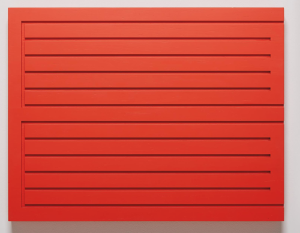255 Worth Avenue
Palm Beach, FL 33480
T 561.328.9504
Lisa@borghi.org
Monochrome Minimalism 1959-Present
January 4, 2016– February 29, 2016
-

Donal Judd Untitled (woodblock, 89-32) 1989
Oil on wood 16 x 20 3/4 inchesMonochrome Minimalism 1959-Present
Monochrome-Minimalism 1959 to the Present. Easily the most striking of these is an untitled Robert Morris wall sculpture. This memento mori uses plaster imprinted with bones and body parts to conjure the horror of nuclear Armageddon in the manner of an ancient architectural site. One of Morris’s Firestorm series, the work dates from 1982, the Reagan-era peak of Cold War tensions. Here again, current events come to mind. Although Morris made his name as a minimalist, he broke the mold with works like this one, tossing aside the cloisters of formalism in favor of raw emotions and painterly gestures that (once again) echo Hofmann and his progeny. Likewise this selection of monochromes breaks with received ideas, broadening the concept to be inclusive of many styles — and colors. Amond these is a cheeky Tom Weselman sculpture of a “dropped bra” in green, Yves Klein’s homage to Michelangelo in his trademark blue, and a red Donal Judd. A pair of incredibly rare Andy Warhol paintings in a private collection since 1966 are from his Jackie series, one silver, the other gold, invites contemplation by way of a tabloid image of the mourn- ing Jacqueline Onassis. The results pulse with their own brand of push-pull, shuttling the viewer between heartbreak and glamour. In another work, the large black-and-white unique screen-print, “Tres Amici,” Warhol joins with artist pals Jean Michel Basquiat and Francisco Clemente to sketch a beach scene with two bathers and a “swordfish” (the quotation marks are a dead givaway that the fish belongs to Basuiat.) The most recent of the monochromes is a Richard Prince form 2014, the latest iteration of the artist’s Joke series. The canvas is covered in bright, white impasto save for a single tiny word isolated from a New York Times article: “brilliant.” Is this a sly expression of self-regard or a reference to a shade of the paint? In either case, it’s easy to agree.
